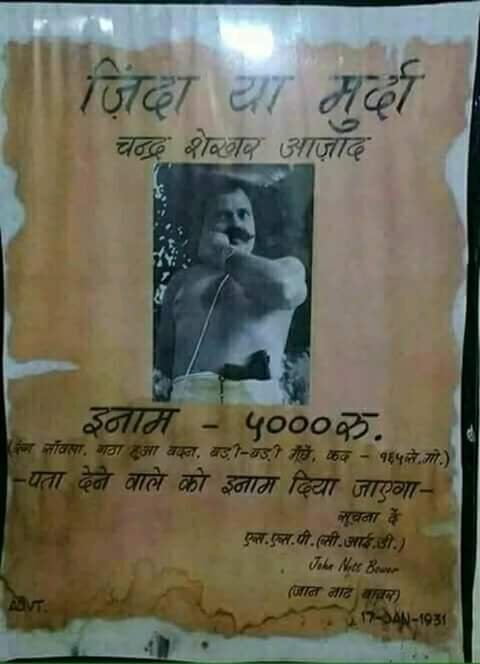Azad was born as Chandrashekhar Tiwari on 23 July 1906 in Bhavra village, in the present-day Alirajpur district of Madhya Pradesh. His forefathers were from Badarka village near Kanpur (in present-day Unnao District). His mother, Jagrani Devi Tiwari, was the third wife of Sitaram Tiwari, whose previous wives had died young. After the birth of their first son, Sukhdev Tiwari, in Badarka, the family moved to Alirajpur State.
A monument to Chandra Shekhar Azad in his ancestral village of Badarka
His mother wanted her son to be a great Sanskrit scholar and persuaded his father to send him to Kashi Vidyapeeth, Banaras, to study. In December 1921, when Mohandas K. Gandhi launched the Non-Cooperation Movement, Chandra Shekhar, then a 15-year-old student, joined. As a result, he was arrested. On being produced before a magistrate, he gave his name as "Azad" (The Free), his father's name as "Swatantrata" (Independence) and his residence as "Jail". From that day he came to be known as Chandra Shekhar Azad among the people.[6]
Revolutionary lifE
After suspension of the non-cooperation movement in 1922 by Gandhi, Azad became more aggressive. He met a young revolutionary, Manmathnath Gupta, who introduced him to Ram Prasad Bismil who had formed the Hindustan Republican Association (HRA), a revolutionary organisation. Bismil was impressed by Azad, when Azad reportedly put his hand over a lamp and did not remove it until his skin burnt. He then became an active member of the HRA and started to collect funds for HRA. Most of the fund collection was through robberies of government property. He also wanted to build a new India based on socialist principles. He was involved in the Kakori Train Robbery of 1925, in the attempt to blow up the Viceroy of India's train in 1926, and at last the shooting of J. P. Saunders at Lahore in 1928 to avenge the killing of Lala Lajpat Rai.[citation needed]
Despite being a member of Congress, Motilal Nehru regularly gave money in support of Azad.
Activities in Jhansi
Azad made Jhansi his organisation's hub for some time. He used the forest of Orchha, situated 15 kilometres (9.3 mi) from Jhansi, as a site for shooting practice and, being an expert marksman, he trained other members of his group. He built a hut near to a Hanuman temple on the banks of the Satar River and lived there under the alias of Pandit Harishankar Brahmachari for a long period. He taught children from the nearby village of Dhimarpura (now renamed Azadpura by the Government of Madhya Pradesh) and thus managed to establish good rapport with the local residents.
While living in Jhansi, he also learned to drive a car at Bundelkhand Motor Garage in Sadar Bazar. Sadashivrao Malkapurkar, Vishwanath Vaishampayan and Bhagwan Das Mahaur came in close contact with him and became an integral part of his revolutionary group. The then congress leaders from Raghunath Vinayak Dhulekar and Sitaram Bhaskar Bhagwatwere also close to Azad. He also stayed for sometime in the house of Rudra Narayan Singh at Nai Basti, as well as Bhagwat's house in Nagra.
With Bhagat SinghEdit
The Hindustan Republican Association (HRA) was formed by Bismil, Chatterji, Sachindra Nath Sanyal and Shachindra Nath Bakshi in 1924. In the aftermath of the Kakori train robbery in 1925, the British clamped down on revolutionary activities. Prasad, Ashfaqulla Khan, Thakur Roshan Singh and Rajendra Nath Lahiri were sentenced to death for their participation. Azad, Keshab Chakravarthy and Murari Sharmaevaded capture. Chandra Shekhar Azad later reorganised the HRA with the help of revolutionaries like Sheo Verma and Mahaveer Singh.
Azad and Bhagat Singh secretly reorganised the HRA as the HSRA in September 1928.so as to achieve their primary aim of an independent India based on socialist principle. The insight of his revolutionary activities are described by Manmath Nath Gupt a fellow member of HSRA in his numerous writings. Gupta has also written his biography titled "Chandrashekhar Azad" and in his book History of the Indian Revolutionary Movement (English version of above: 1972) he gave a deep insight about the activities of Azad and the ideology of Azad and HSRA.[citation needed]
Death
The tree in Alfred Park, Allahabad, where Azad died
Statue of Azad at Azad Park, Allahabad
Azad died at Alfred Park in Allahabad on 27 February 1931. The police surrounded him in the park after an unknown informant told them he was there. He was wounded in the process of defending himself and Sukhdev Raj (not to be confused with Sukhdev Thapar) and killed three policemen and wounded some others. His actions made it possible for Sukhdev Raj to escape. After a long shootout, holding true to his pledge to never be captured alive, he shot himself dead with his last bullet. The Colt pistol of Chandra Shekhar Azad is displayed at the Allahabad Museum.
The body was sent to Rasulabad Ghat for cremation without informing general public. As it came to light, people surrounded the park where the incident had taken place. They chanted slogans against the British rule and praised Azad

Hi! I am a robot. I just upvoted you! I found similar content that readers might be interested in:
https://en.wikipedia.org/wiki/Chandrashekhar_Azad